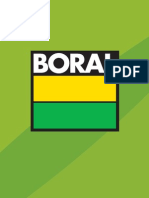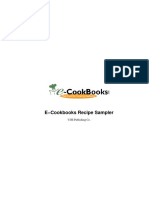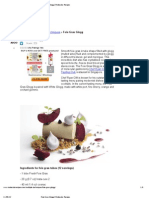History of Couscous
History of Couscous
Uploaded by
anikeitCopyright:
Available Formats
History of Couscous
History of Couscous
Uploaded by
anikeitOriginal Description:
Copyright
Available Formats
Share this document
Did you find this document useful?
Is this content inappropriate?
Copyright:
Available Formats
History of Couscous
History of Couscous
Uploaded by
anikeitCopyright:
Available Formats
History[edit] One of the first written references is from an anonymous 13th-century North Afri can cookbook, Kitab al-tabikh
fi al-Maghrib (North Africa) wa'l-Andalus (Arabic) "The cookbook of the Maghreb and Al-Andalus", with a recipe for couscous that w as 'known all over the world'. To this day, couscous is known as 'the North Afri ca national dish'.[9] Couscous was known to the Nasrid royalty in Granada as wel l. And in the 13th century a Syrian historian from Aleppo includes four referenc es for couscous. These early mentions show that couscous spread rapidly, but gen erally that couscous was common from Tripolitania to the west, while from Cyrena ica to the east the main cuisine was Egyptian, with couscous as an occasional di sh. Today, in Egypt and the Middle East, couscous is known, but in Algeria, Moro cco, Tunisia and Libya couscous is a staple. It is the national dish of Algeria. [10] Couscous was taken from Syria to Turkey in the 16th century and is eaten in most of the southern provinces. Couscous is a traditional meal of the cuisine from Trapani. In Rome Bartolomeo S cappi's culinary guide of 1570 describes a Moorish dish, succussu; in Tuscany.[1 1] One of the earliest references to couscous in France is in Brittany, in a letter dated January 12, 1699. But it made an earlier appearance in Provence, where th e traveler Jean-Jacques Bouchard wrote of eating it in Toulon in 1630. Couscous was originally made from millet.[12] Historians have different opinions as to wh en wheat began to replace the use of millet. The conversion seems to have occurr ed sometime in the 20th century, although many regions continue to use the tradi tional millet. Couscous seems to have a North African origin. Archaeological evi dence dating back to the 10th century, consisting of kitchen utensils needed to prepare this dish, has been found in this part of the world. In some regions couscous is made from coarsely ground barley or pearl millet. In Brazil, the traditional couscous is made from cornmeal.[13] Preparation[edit]
Couscous with vegetables The semolina is sprinkled with water and rolled with the hands to form small pel lets, sprinkled with dry flour to keep them separate, and then sieved. Any pelle ts which are too small to be finished granules of couscous and fall through the sieve are again rolled and sprinkled with dry semolina and rolled into pellets. This process continues until all the semolina has been formed into tiny granules of couscous. This process is labour-intensive. In the traditional method of pre paring couscous, groups of women came together to make large batches over severa l days.[citation needed] These were then dried in the sun and used for several m onths. Couscous was traditionally made from the hard part of the durum, the part of the grain that resisted the grinding of the millstone. In modern times, cous cous production is largely mechanized, and the product is sold in markets around the world. In the Sahelian countries of West Asia, such as Mali and Senegal, pearl millet i s pounded or milled to the size and consistency necessary for the couscous.[14]
A couscoussier, a traditional steamer for couscous. Properly cooked couscous is light and fluffy, not gummy or gritty. Traditionally , North Africans use a food steamer (called a ???????? kiskas in Arabic or a cou scoussire in French). The base is a tall metal pot shaped rather like an oil jar in which the meat and vegetables are cooked as a stew. On top of the base, a ste amer sits where the couscous is cooked, absorbing the flavours from the stew. Th e lid to the steamer has holes around its edge so steam can escape. It is also p ossible to use a pot with a steamer insert. If the holes are too big the steamer can be lined with damp cheesecloth. There is little archaeological evidence of early diets including couscous, possibly because the original couscoussire was pr obably made from organic materials which could not survive extended exposure to the elements. Instant couscous[edit] The couscous that is sold in most Western supermarkets has been pre-steamed and dried, the package directions usually instruct to add 1.5 measures of boiling wa ter or stock and butter to each measure of couscous and to cover tightly for 5 m inutes. The couscous swells and within a few minutes it is ready to fluff with a fork and serve. Pre-steamed couscous takes less time to prepare than regular co uscous, most dried pasta, or dried grains such as rice. Local variations[edit]
Couscous with raisin and onion topping In Algeria, Morocco, Tunisia, and Libya couscous is generally served with vegeta bles (carrots, potatoes, turnips, etc.) cooked in a spicy or mild broth or stew, and some meat (generally, chicken, lamb or mutton). In Algeria and Morocco it is also served, sometimes at the end of a meal or just by itself, as a delicacy called "seffa". The couscous is usually steamed severa l times until it is very fluffy and pale in color. It is then sprinkled with alm onds, cinnamon and sugar. Traditionally, this dessert is served with milk perfum ed with orange flower water, or it can be served plain with buttermilk in a bowl as a cold light soup for supper. In Libya, it is mostly served with meat, specifically beef, lamb, or camel, in T ripoli and the western parts of Libya, but not during official ceremonies or wed dings. Another way to eat couscous is as a dessert; it is prepared with dates, s esame, and pure honey, and locally referred to as "maghrood". In Tunisia, it is made mostly spicy with harissa sauce and served with almost ev erything, including lamb, beef, camel, and poultry. Fish couscous is a Tunisian specialty and can also be made with octopus in hot, red, spicy sauce. Couscous i n Tunisia is served on every occasion; it is also served, mostly during Ramadan, sweetened as a dessert called masfouf. In Egypt, couscous is eaten more as a dessert. It is prepared with butter, sugar , cinnamon, raisins, and nuts and topped with cream. Couscous is also very popular in France, where it is now considered a traditiona l dish, and has also become popular in Spain, Portugal, Italy, and Greece. Indee d, many polls have indicated that it is often a favorite dish.[15] Although intr oduced in France by the pieds noirs (people of European descent who used to live in Algeria), many couscous restaurants are now owned by people originating from Algeria. In France, Spain, Italy, and Portugal, the word "couscous" (cuscs in Sp
anish, Portuguese, and Italian) usually refers to couscous together with the ste w. Packaged sets containing a box of quick-preparation couscous and a can of veg etables and, generally, meat are sold in French, Spanish, Italian, and Portugues e grocery stores and supermarkets. In France, it is generally served with hariss a sauce. In North America, Australia, and the United Kingdom, couscous is available most commonly either plain or pre-flavoured in quick-preparation boxes. In the United States, it is widely available, normally found in the ethnic or health-food sec tion of larger grocery stores.
You might also like
- Boral Roof Tile ManualDocument130 pagesBoral Roof Tile ManualVu BuiNo ratings yet
- Home Cooking With Julie GoodwinDocument6 pagesHome Cooking With Julie GoodwinRalph MoserNo ratings yet
- Frs Assignment 2Document15 pagesFrs Assignment 2Sharmila Devi100% (1)
- History of BakingDocument13 pagesHistory of Bakingbea bagsaoNo ratings yet
- Santesson Recipe Collection Swedish Cooking PDFDocument37 pagesSantesson Recipe Collection Swedish Cooking PDFAfiq BahaNo ratings yet
- Idli Milagai Podi RecipeDocument4 pagesIdli Milagai Podi RecipeProf C.S.Purushothaman100% (1)
- (The Global Kitchen) Maryann Tebben - Food Cultures of France - Recipes, Customs, and Issues (2021, Greenwood - ABC-CLIO) - Libgen - LiDocument242 pages(The Global Kitchen) Maryann Tebben - Food Cultures of France - Recipes, Customs, and Issues (2021, Greenwood - ABC-CLIO) - Libgen - LiriverherizoNo ratings yet
- Austral IA: Spinach RiceDocument94 pagesAustral IA: Spinach Ricepallumehra2845No ratings yet
- Mexican Food and Culture Fact SheetDocument3 pagesMexican Food and Culture Fact SheetPrincess Villasis BaciaNo ratings yet
- Types of CookiesDocument9 pagesTypes of CookiesCristy R. GarcesNo ratings yet
- Mother Sauces DessertDocument6 pagesMother Sauces DessertvorexxetoNo ratings yet
- Vegan Thanksgiving RecipesDocument8 pagesVegan Thanksgiving RecipesUkiah Natural Foods Co-opNo ratings yet
- Msuspcsbs Swan Igleheartb21 PDFDocument68 pagesMsuspcsbs Swan Igleheartb21 PDFAmy SNo ratings yet
- TYPES OF CAKE Rioflorido, JanineDocument6 pagesTYPES OF CAKE Rioflorido, JanineJanine RiofloridoNo ratings yet
- Danish Pastries: Chapter Thirty-OneDocument1 pageDanish Pastries: Chapter Thirty-Onemohamed.mauroofNo ratings yet
- Alf's CookbookDocument205 pagesAlf's CookbookggcravenNo ratings yet
- 2013 Vegan Food Fair Recipe BookletDocument40 pages2013 Vegan Food Fair Recipe Bookletspiraldao100% (1)
- FishcakeDocument10 pagesFishcakeUtpalSaha0% (1)
- Food Culture in BelgiumDocument261 pagesFood Culture in BelgiumclaudioNo ratings yet
- Beef Mechado: Ingredients: ProceduresDocument6 pagesBeef Mechado: Ingredients: ProceduresCandy SilverioNo ratings yet
- Vegan Zine-AnDocument8 pagesVegan Zine-AnKaarina Alba Sorensen-JarrettNo ratings yet
- Spanish Food PresentationDocument8 pagesSpanish Food PresentationJohanna De FreitasNo ratings yet
- La Cuisinère Canadienne - The Cookbook As CommunicationDocument19 pagesLa Cuisinère Canadienne - The Cookbook As CommunicationSandra MianNo ratings yet
- Creamy Vegan Ramen - PrintDocument2 pagesCreamy Vegan Ramen - PrintSylvia DuranNo ratings yet
- Guide To Cooking PulsesDocument2 pagesGuide To Cooking PulsesCasio ClockNo ratings yet
- Tupperware Apple Orchard SalsaDocument1 pageTupperware Apple Orchard SalsaMaryse LapointeNo ratings yet
- Vegan Pantry StaplesDocument7 pagesVegan Pantry StaplesAshleigh MaudeNo ratings yet
- IKEA Food KitDocument28 pagesIKEA Food KitArti PatelNo ratings yet
- Ch-3 Indian CusineDocument100 pagesCh-3 Indian CusineGauravNo ratings yet
- Vegan Bolognese Sauce Recipe (With Lentils) - Elavegan PDFDocument2 pagesVegan Bolognese Sauce Recipe (With Lentils) - Elavegan PDFSylvia DuranNo ratings yet
- It’S Just Better . . . in a Bowl!: Cooking Real Food for a Healthier YouFrom EverandIt’S Just Better . . . in a Bowl!: Cooking Real Food for a Healthier YouNo ratings yet
- Juicy Pub-Style Burgers - Cooks IllustratedDocument2 pagesJuicy Pub-Style Burgers - Cooks IllustratedDamon ChitsazNo ratings yet
- Vitacost 30 Recipes Under 30 Minutes Vitacost e BookDocument36 pagesVitacost 30 Recipes Under 30 Minutes Vitacost e BookbionikaNo ratings yet
- Sapin Sapin: IngredientsDocument3 pagesSapin Sapin: IngredientsYvet KatNo ratings yet
- German Cities and German CuisineDocument5 pagesGerman Cities and German CuisineAyush ChoudharyNo ratings yet
- Adobong Puti (White Chicken Adobo) : IngredientsDocument36 pagesAdobong Puti (White Chicken Adobo) : IngredientsFrancisco Severino Gatoc Jr.No ratings yet
- Cuisine of KarnatakaDocument5 pagesCuisine of KarnatakaPiyush AgarwalNo ratings yet
- Recetas de CocinaDocument194 pagesRecetas de CocinaOSCAR DE JESUS FLORESNo ratings yet
- Bhandare Wale Aloo Ki Sabzi Recipe I Aloo Sabzi Recipe - Video RecipeDocument2 pagesBhandare Wale Aloo Ki Sabzi Recipe I Aloo Sabzi Recipe - Video Recipegsekar74No ratings yet
- Lebanese CookingDocument12 pagesLebanese CookingZia khanNo ratings yet
- Culture - Spanish Eating CustomsDocument1 pageCulture - Spanish Eating CustomsJoaquin100% (2)
- Step-by-Step Instructions: The Ultimate CrêpesDocument1 pageStep-by-Step Instructions: The Ultimate CrêpesurijeNo ratings yet
- E Cookbooks Recipe Sampler: VJJE Publishing CoDocument31 pagesE Cookbooks Recipe Sampler: VJJE Publishing CovalentindanielNo ratings yet
- Sourdough Crackers King Arthur BakingDocument1 pageSourdough Crackers King Arthur BakingFernanda SantosNo ratings yet
- Provence Recipes From The French Mediterranean Caroline CraigDocument324 pagesProvence Recipes From The French Mediterranean Caroline CraigAxel GuillenrNo ratings yet
- Sporting Chef's Scott Leysath Favorite RecipesDocument37 pagesSporting Chef's Scott Leysath Favorite RecipesAmmoLand Shooting Sports NewsNo ratings yet
- Tres Leches Cupcakes RecipesDocument9 pagesTres Leches Cupcakes RecipesCaroline MusoleNo ratings yet
- Cream of Palak PannerDocument13 pagesCream of Palak PannerBhadresh NarayananNo ratings yet
- Foie Gras Glogg - Molecular RecipesDocument6 pagesFoie Gras Glogg - Molecular RecipesAriel Fragoso100% (1)
- Canadian Living Bake Fest 2009 Recipe BookletDocument14 pagesCanadian Living Bake Fest 2009 Recipe BookletAriana Pazzini100% (1)
- Feijoada Pao de Quejo Moqueqa de Peixe Rice Brigadeiros (Dessert) Guarana (Beverage)Document6 pagesFeijoada Pao de Quejo Moqueqa de Peixe Rice Brigadeiros (Dessert) Guarana (Beverage)Gilberth Eduardo FajardoNo ratings yet
- Potjiekos RecipesDocument8 pagesPotjiekos RecipesWaldo KühnNo ratings yet
- Perfecting Past in Spanish ExercisesDocument68 pagesPerfecting Past in Spanish ExercisesDmytro CherednichenkoNo ratings yet
- Breakfast BrunchDocument28 pagesBreakfast Brunchjoseolim6536No ratings yet
- Blueberry Tea CakeDocument43 pagesBlueberry Tea CakeScholastykaNo ratings yet
- Homemade Ciabatta Bread - Baked by An IntrovertDocument4 pagesHomemade Ciabatta Bread - Baked by An IntrovertMysura MNo ratings yet
- Food Plating Tips For Plating Your FoodDocument15 pagesFood Plating Tips For Plating Your FoodRaphael samboNo ratings yet
- Vegan Ravioli ReceipesDocument21 pagesVegan Ravioli Receipesliaya76No ratings yet
- Scrumptious Vegan Recipes From VivaDocument2 pagesScrumptious Vegan Recipes From VivaVegan Future50% (2)
- Food Lovers Bucket ListDocument40 pagesFood Lovers Bucket Listfrances-asalgueiroNo ratings yet
- Temperature Guide For Indian CookingDocument2 pagesTemperature Guide For Indian CookingrathoduNo ratings yet
- LingaaDocument2 pagesLingaaanikeitNo ratings yet
- Standard Work Questions To Ask On The GembaDocument2 pagesStandard Work Questions To Ask On The Gembaanikeit100% (1)
- Impression ManagementDocument5 pagesImpression ManagementanikeitNo ratings yet
- Negotiation GameDocument4 pagesNegotiation Gameanikeit100% (2)
- The Five-Minute: Improve Performance - RapidlyDocument14 pagesThe Five-Minute: Improve Performance - Rapidlymaggy_dolly41725% (4)
- Jollof RiceDocument1 pageJollof RiceanikeitNo ratings yet
- KenkeyDocument2 pagesKenkeyanikeitNo ratings yet
- SkilpadjiesDocument1 pageSkilpadjiesanikeitNo ratings yet
- InjeraDocument2 pagesInjeraanikeitNo ratings yet
- HelvaDocument2 pagesHelvaanikeitNo ratings yet
- List of Best Negotiation BooksDocument2 pagesList of Best Negotiation BooksanikeitNo ratings yet
- (1920) Rennie's Seed Annual & Garden Guide For 1920 (Catalogue)Document88 pages(1920) Rennie's Seed Annual & Garden Guide For 1920 (Catalogue)Herbert Hillary Booker 2ndNo ratings yet
- Corrosion Coupon Installation Procedure PDFDocument31 pagesCorrosion Coupon Installation Procedure PDFtrichysayeeNo ratings yet
- Kcse Mathematics Final Prediction 2023Document115 pagesKcse Mathematics Final Prediction 2023micah isaboke100% (2)
- Marketing Assistant CV TemplateDocument2 pagesMarketing Assistant CV TemplateHuyền HoàngNo ratings yet
- Foundry Technology: Department of Metallurgical and Materials EngineeringDocument11 pagesFoundry Technology: Department of Metallurgical and Materials EngineeringAnkitNo ratings yet
- ADSS DirectoryDocument55 pagesADSS DirectoryResers xNo ratings yet
- Forlan Investments...Document1 pageForlan Investments...Muka MuntangaNo ratings yet
- Environmental Management Plan ChecklistDocument2 pagesEnvironmental Management Plan ChecklistDodik ParulianNo ratings yet
- Digital Assignment-8: CLE3999 Technical Answers To The Real World ProblemsDocument5 pagesDigital Assignment-8: CLE3999 Technical Answers To The Real World ProblemsshubhamNo ratings yet
- Compiler Design PDFDocument313 pagesCompiler Design PDFnitin_y11No ratings yet
- TDS - Synolac S63Document2 pagesTDS - Synolac S63I Love MusicNo ratings yet
- Kingstar Lighting InductionDocument8 pagesKingstar Lighting Inductionapi-194673166No ratings yet
- VARIMADocument4 pagesVARIMAxayzh123No ratings yet
- Sekolah Tun Fatimah - Google SearchDocument1 pageSekolah Tun Fatimah - Google Searchnurqaleesyad07No ratings yet
- Audrey Dunham v. Paige Dunham Complaint PDFDocument10 pagesAudrey Dunham v. Paige Dunham Complaint PDFMark JaffeNo ratings yet
- Value Chain Management: The Concept of Value Addition in Supply ChainsDocument23 pagesValue Chain Management: The Concept of Value Addition in Supply ChainsANo ratings yet
- IM Readings in Philippine HistoryDocument101 pagesIM Readings in Philippine HistoryXzailheene Dela FuenteNo ratings yet
- End-To-End Testing in Azure Pipelines Using Nightwatch - Js - CodeProjectDocument11 pagesEnd-To-End Testing in Azure Pipelines Using Nightwatch - Js - CodeProjectgfgomesNo ratings yet
- Exercise 10Document7 pagesExercise 10Thaoanh NguyenNo ratings yet
- Matching Buyers and SuppliersDocument1 pageMatching Buyers and SuppliersSky LoveNo ratings yet
- Principles of Geographic Information Systems (GIS)Document67 pagesPrinciples of Geographic Information Systems (GIS)Beatrice LyasengaNo ratings yet
- Grade 7, and 8 Unit Plan: BadmintonDocument28 pagesGrade 7, and 8 Unit Plan: Badmintonapi-528183331No ratings yet
- Case Study On OPPODocument11 pagesCase Study On OPPOMirza Junaid0% (2)
- Classical Mechanics Systems of Particles and Hamiltonian Dynamics, Second Edition, Walter Greiner 9783642034688Document598 pagesClassical Mechanics Systems of Particles and Hamiltonian Dynamics, Second Edition, Walter Greiner 9783642034688Ravi Pratap100% (2)
- Art 3Document11 pagesArt 3HNo ratings yet
- 15 - The Dangers of Bank SuctionDocument2 pages15 - The Dangers of Bank SuctionEdi UnusicNo ratings yet
- Smelting GoldDocument2 pagesSmelting Gold69afreak69100% (2)
- Aqua CultureDocument21 pagesAqua CultureMahnoor AkbarNo ratings yet




































































































